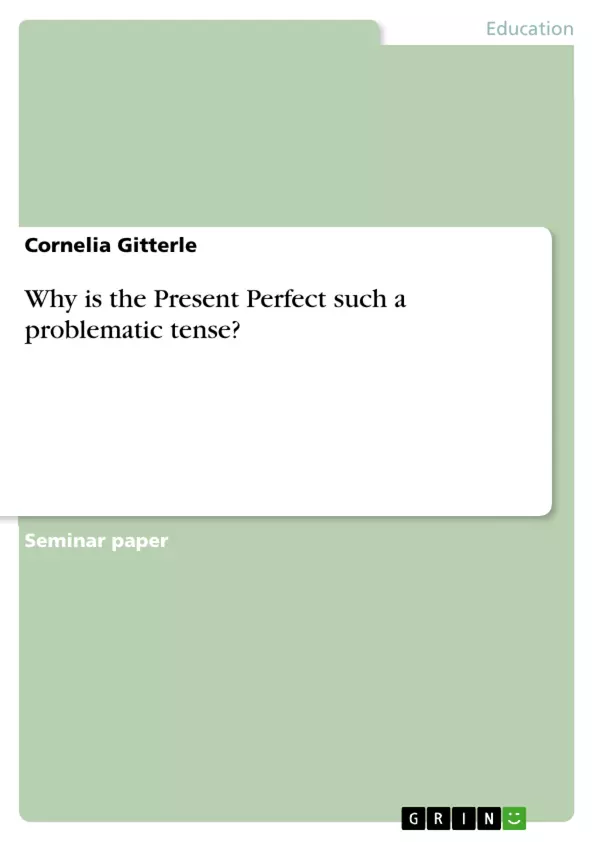It has to be mentioned that this paper mainly deals with the Present Perfect Simple because otherwise this topic would have become too complex. Furthermore, the present perfect is not always used the same way in British and American English. In the current paper, however, the used examples represent British Standard English. It will be shown that the Present Perfect is a problematic tense to learn and to teach because it has so many notions and uses.
It will be proved that a major difficulty in learning this tense arises from the interference from the learner‘s mother tongue. As far as teaching is concerned, when introducing a new piece of grammar we always have to teach not only the form, but also its functions, and not only meaning but also use. Therefore, teaching the present perfect is quite a difficult task.
This paper will also discuss critical questions teachers should ask themselves and the various notions and uses of the present perfect in detail, providing at the same time possible ways of teaching them with quoted activities from different coursebooks.
Table of Contents
- 1. Introduction
- 2. Interference from the mother tongue
- 3. How can the present perfect be teached?
- 3.1. Rules of thumb
- 3.2. Different Approaches to teaching the present perfect
- 4. Grammar spot
- 5. Different Notions of the present perfect tense - Activities to practice them – Critical comments
- 5.1. Experiences
- 5.2. Present Result
- 5.3. Recent Actions/Events
- 5.3.1. A mistaken idea
- 5.4. Unfinished Past/Duration
- 5.5. Indefinite Time
- 6. Contrasting Present Perfect – Past Simple
- 7. Conclusion
Objectives and Key Themes
This paper examines the challenges of learning and teaching the Present Perfect tense in English, focusing on the complexities of its various notions and uses. It highlights the impact of interference from learners' mother tongues, particularly German, and explores different approaches to teaching this tense effectively. The paper emphasizes the importance of considering both the form and function of the tense, as well as its contextual usage.
- Difficulties in learning the present perfect tense due to interference from the learner's mother tongue.
- The importance of teaching both the form and function of the present perfect tense.
- Different approaches to teaching the present perfect tense, including rules of thumb and inductive methods.
- The various notions of the present perfect tense and their implications for teaching and learning.
- The importance of contrasting the present perfect tense with other tenses, particularly the past simple.
Chapter Summaries
The paper begins by introducing the focus of the study, which is the Present Perfect Simple tense in British English. Chapter 2 explores the challenges faced by learners whose mother tongues do not have a corresponding tense that encompasses all the notions of the English Present Perfect. It highlights the common mistakes made by German learners and analyzes the reasons behind them. Chapter 3 delves into the complexities of teaching the present perfect tense, addressing questions teachers should consider, such as how to introduce the tense, which notions to prioritize, and the effectiveness of rules of thumb versus inductive approaches. Chapter 4 focuses on contrasting the present perfect with the past simple, highlighting the differences in their meaning and usage. While the paper does not include summaries of the conclusion or final chapter, it provides a detailed overview of the challenges and strategies associated with teaching and learning the present perfect tense.
Keywords
The primary focus of this paper is the Present Perfect Simple tense in English, specifically addressing its challenges for learners and teachers. Key themes include interference from the mother tongue, particularly German, different approaches to teaching the tense, and the various notions and functions of the present perfect, including its relationship to the past simple. This paper highlights the importance of considering context and usage when teaching grammar, demonstrating the complexities of the Present Perfect tense and providing insights into effective teaching strategies.
- Quote paper
- Cornelia Gitterle (Author), 2003, Why is the Present Perfect such a problematic tense?, Munich, GRIN Verlag, https://www.grin.com/document/39830



